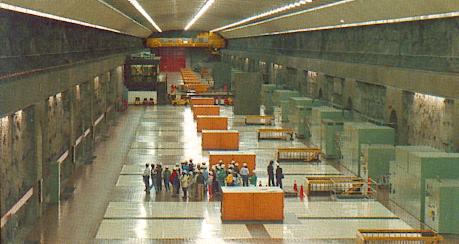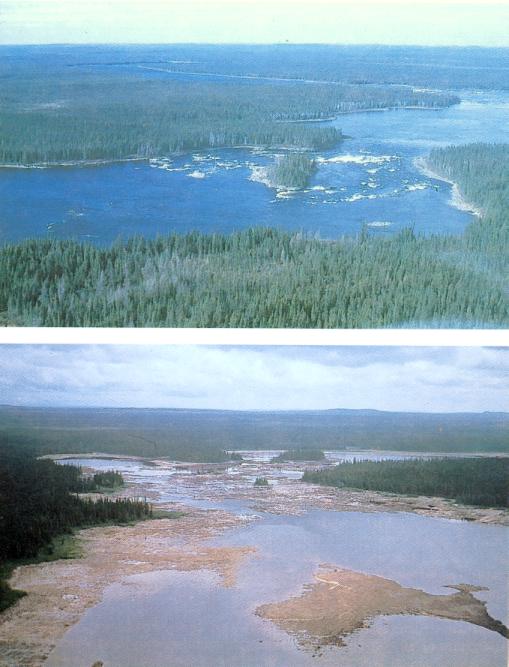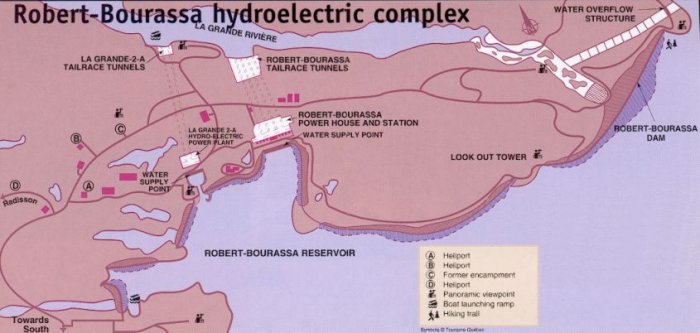 |
|
 |
|
Hydro-Quebec Project
|
| |
|
The only reason for building the Roads leading up to James Bay (James
Bay Road, Trans Taiga Road,
North Road) was to deliver equipment and supplies to the giant multi-billion
dollar James Bay Hydro-Electric project.
This page explains a little about the project and its impact.
From 1950-1970 studies were made of the hydro-electric potential of the
region of Quebec east of James Bay. In April 1971 Robert Bourassa announced the
development of the La Gande complex, calling it "the project of the century."
The James Bay Road was built starting in 1971,
and took 400 days to complete. All equipment and supplies for the project were
to be transported up this road.
Unfortunately, work started without any consideration of the original
inhabitants of the area. The area was generally uninhabited by white people, but
had been the home for thousands of years of the Cree Indians. An injunction won
by the Cree to stop work in Nov 1973 was overturned a short time later by Hydro
Quebec. Negotiations were then undertaken to arrive at a final treaty between
the native people and the various governments and Hydro Quebec, to allow the
project to proceed unhindered by future legal battles. In November 1975, the
"James Bay and Northern Quebec Agreement" was signed. This "settled" the Native
Cree's land claim for the area, leaving them with areas of land for their own
use and a payment of $167 million (later payments brought this to a total of
$600 million). With the large influx of southerners and southern ways, their old
way of life was devastated. Alcoholism and all of the other related
problems descended on them and tore apart their established way of life that was
thousands of years old. They experienced staggering social problems brought on
by the huge influx of outsiders, such as alcohol and drug abuse, prostitution,
family violence, etc, problems which continue today. Today they have to some
extent adapted to the changes. Many local Cree have jobs with Hydro
Quebec. |
| |
 |
The Cree signing away their rights to a vast area of northern Quebec.
...Not that they had much choice in the matter....
|
|
| |
|
In October 1979 the first generating unit at LG-2 was started. The last one
to go online was Laforge-2, in December 1996.
Altogether, the entire project cost $17.5 billion! Taken together, all seven
generating stations produce 15,244 MW of electricity. In contrast, all of the
hydro-generation plants at Niagara Falls generate 4,400 MW of electricity.
Apparently half of the electricity generated in Quebec is generated here.
According to Hydro Quebec, none of this power is sold outside of Quebec.
However, the power generated by these installations allows power generated by
other means within Quebec to be sold to the United States! |
| |
 |
The largest of these is LG-2, now known as Robert-Bourassa.
It has the largest underground powerhouse in the world, shown here
-- almost 1/2 km long.
There are actually two hydro-electric plants in this part of the
project: LG-2 (Robert-Bourassa) and LG-2A. Their combined output of
7,326 MW of electricity make this the third largest hydro-electric
plant in the world.
|
|
| |
|
To generate these amounts of electricity, the La Grande
River had to be dammed for most of its length, and some of the water
from two other drainage basins had to be diverted to add to its flow.
Here are before and after photos of the Eastmain River.
90% of the flow of this river was diverted northward to the La Grande
River. The same thing will soon happen also to the mighty
Rupert River. |
|

|
| |
| In 2002 an agreement was signed with the Cree allowing Hydro
Quebec to possibly proceed with further projects in the area,
including one that would divert the magnificent
Rupert River. For more
information, please visit the
Rupert River website. |
| |
| Here is a diagram of the profile of the La Grande River, after
being modified by the dams placed across it. Essentially it has been
turned into a series of lakes. |
|
|
|

|
| |
|
Other problems caused by this massive project were the release of
organic mercury into the water of the reservoirs from decaying trees,
interference with fish populations (they are sucked into the turbines),
obvious problems arising from diversion of significant portions of the
flows of large rivers, disruption of animal populations, severe
alteration of a traditional way of life of the local native people, the
removal of vegetation from the usual construction activities, and so on.
To their credit, Hydro Quebec did plant millions of trees and shrubs,
and built weirs at certain key locations in an attempt to simulate the
full flow of diverted rivers, hired a certain proportion of native
people on the project, etc.
The environmental impact of such a large project can probably never be
fully measured. Hydro-electric power is often argued as being fairly
benign environmentally, in comparison with gas, oil, coal-fired or
nuclear generating facilities. While those have obvious air pollution or
long-term waste issues and problems, the actual installations cover a
much smaller area. Also, the dams needed for most hydro-electric
developments inundate sometimes very large areas of land. Altogether the
reservoirs created by the James Bay Project cover an area of 13,341
square kilometers - the largest bodies of water ever created by
humankind. One of the reservoirs, Caniapiscau, is the largest freshwater
lake in Quebec. So, the debate continues over the relative impacts of
the various methods of generating electricity. Do we really need this
electricity? It is likely that conservation efforts would eliminate the
need to subjugate the wilderness to this purpose. On the other hand, if
this power is truly needed, what would the alternative of generating it
by coal, gas and oil-fired power plants look like? Or what about more
benign methods of power generation, such as solar and wind power, and
other smaller scale methods? |
| |
|
Links to sites about Hydro Quebec
|
|

|
| |
|
(None of the photographs on this page were taken by Walter
Muma) |
|

